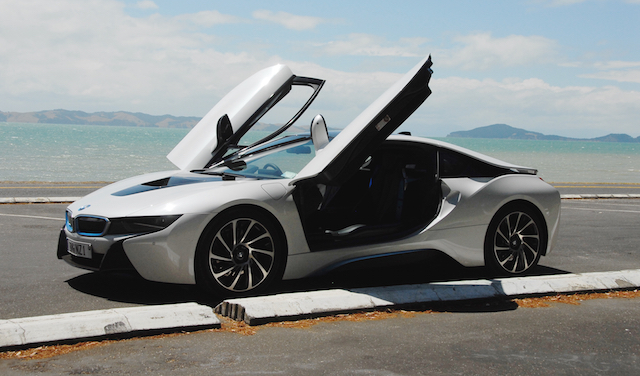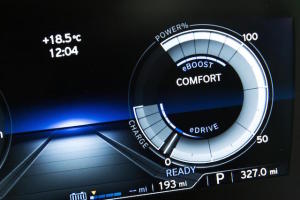
BMW expects New Zealanders to buy 10 examples of the i8 supercar in 2015. “Some have buyers’ names on them already, some will be going to our dealer network to sell,” said BMW NZ communications manager Ed Finn.
Those who part with $NZ278,000 for the petrol-electric coupe won’t be able to slip anonymously into traffic anywhere in this country. The one example that BMW has been showing off around Auckland since before Christmas has been a magnet.
It drew the inevitable crowd at celebrations over Auckland’s 175th Anniversary weekend. Onlookers who pawed over its sculptured carbon-fibre skin were asked by its minder Finn to guess the price.

“Almost all the replies were between $400,000 and $600,000,” he said. “Most people were genuinely surprised when I told them the price. That’s the drive-away price, too.”
Again it drew a crowd away from downtown Auckland, this time parked off the scenic Maraetai Coast Rd, east of the city. Motorists stopped. What is it? Could they sit in it? Could the kids sit in it? Out came the iPhones and Facebook postings.
Automotive News NZ was filming it for a competition on BMW NZ’s Facebook page. The winner will get to drive the i8 on the Hampton Downs race track; BMW driver-trainer Mike Eady will do the hot laps. • Go to: Facebook.com/bmwnewzealand
It is then that the car will reveal its true potential, the oomph from its combined 266kW/570Nm hybrid drivetrain restrained only by Eady’s expertise. There will be no cars and trucks coming the other way.
So what’s it all about, this futuristic flyer with its 1.5-litre three-cylinder engine borrowed from the new Mini range and coupled to electric motors and a generator? It’s the halo car of BMW’s ‘i’, or ‘green’ brand – a high-tech model that can be both fuel-efficient and fast. How it’s built, what it’s made of, how it works … will help shape future mainstream models from BMW.

Up close, the striking design features come to life, particularly the aerodynamic ‘tunnel’ between the LED tail-lights and floating C-pillar. This almost voluptuous shape looks better again rearward in the car’s side mirrors.
You get into the i8 by parking your backside on the wide door sill and pivoting on it to swing and slide yourself into the driver’s seat. Once in you reach out and pull down the door. Don’t try and pull the door in behind you – BMW won’t pay the chiropractor’s bill.
The cabin is familiar, the BMW family controls blending with exclusive i8 elements like the digital instrument readout. It is not as cramped as you might imagine, but there is little in the way of storage space and the back seats are suitable only for tiny-tots or a couple of overnight bags. The boot itself is slightly bigger than an airline cabin case.
Ahead of the boot and behind the cabin is the turbocharged 1.5-litre three-cylinder engine that generates 170kW/320Nm to the rear wheels via a six-speed automotive gearbox. It can be slipped into manual mode using the gear lever or steering wheel-mounted paddles. Up front a 96kW/250Nm electric motor with a two-speed gearbox powers the front wheels. Mostly, drive goes to the rear wheels, but front and rear can instantly work together.
BMW claims the i8 drivetrain is good for a 0-100km/h time of 4.4 seconds, identical to that of the M4 coupe and its turbocharged 3.0-litre straight-six engine. But the i8 is quicker in-gear, especially overtaking traffic between 80-120km/h, for example.
I drove the i8 for about 70km, before and after filming. Time enough only to get a feel for it and play briefly with its driving modes, each one highlighted by changing graphics on the instrument panel: a calming blue in Comfort or Eco-Pro and a racy orange in Sport mode.

Comfort eases the car away on its electric motors until, under normal acceleration, the petrol engine chimes in, emitting a muffled exhaust note as it does so. You can spend all day in Comfort.
Eco-Pro is for maximum efficiency. It leaves the three-cylinder engine on call until the driver needs to jump on the throttle for instant oomph. Things change in Eco-Pro: the air-conditioning goes into save-electricity mode and throttle firms up under foot.
Battery-power only mode is e-Drive, good for a real-world 35kms, says BMW. The fun starts in Sport. Flick the gear lever left into manual mode and the 1480kg i8 hunkers down, adding improved throttle response, a louder exhaust note with up and down gear change blips, firmer suspension, and weightier steering feel.
The highlight in Sport is the immediate in-gear oomph under throttle. The petrol engine revs to its 6500rpm limit and the electric motors help to juggle torque as the i8 blasts its way into and out of corners, eased up entering them by ventilated discs all round and shot out the other side by both front and rear wheels working to provide traction and a neutral balance.
In all i8 drive modes the electric power steering is accurate, although there is not a lot in terms of feedback. The suspension is typical BMW, firm but supple. The switch between electric and petrol power is largely seamless, unless deliberately provoked into doing something rash.

BMW claims fuel use for the i8 of 2.1 litres/100km, or 135mpg. That’s pretty much in electric model only. Town-and-around driving should return 7 litres/100km, or 40mpg. Pushing it along in Sport mode will see usage go beyond 9 litres/100km, or worse. Saving fuel use and in turn cutting emissions is what supercars like the i8 are all about.
The i8 is a product of the digital age. It feels digital. Electrics have for all time replaced the seat-of-the-pants feel of hydraulics, once the lifeblood of a good sports car. It has an Edward Scissorhands feel about it. It’s not way the doors are hinged, obvious though they are. It’s more that the car’s an unfinished creation, like the movie character played by Johnny Depp. Exciting, different, imaginative. But it’s sort of an artificial offering, synthetic, in need of something touchy and feely. Great car that it is, like Edward S. it’s not quite complete.
